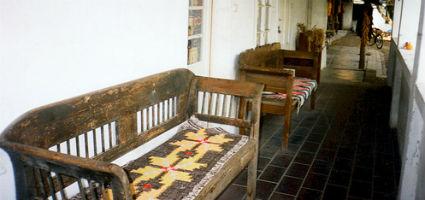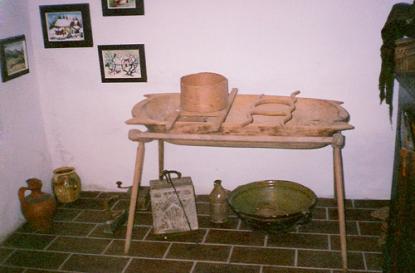2024. November 22. Friday
Szlovakian-Hungarian Region and Art House - Kondoros
 |
Address: 5553, Kondoros Ady Endre u. 12.
Phone number: (66) 388-160
E-mail: polhi@kondorosiktv.hu
Opening hours: Mon-Fri 7:30-12, 12:30-16
|
The interior of the rooms and the kitchen is made up by the peasant-civilian furniture used between the two world wars. They are placed according to the way Hungarian and Slovakian families used them at the time.

Entering the kitchen the door of the oven opens to the left, which is closed with a small panel made from wood. In front of the entrance there is a small window with clay bowls all over around. Underneath there is a kneading bowl with a filter and cross board in connection. Here we can find the flour container, bread holder and irons as well. In the corner there stands a baking board and a cabbage grater. There are glasses, coffee grounder, utility and ornament cups standing on the brown table. Behind the door there stands the water holder table, accompanied by water cans and jars.
Entering the so-called "clean room" we will see a whitewashed oven straight away. To the right, by the side of the wall there is a bed with a sheet embroidered with blue silk. Above it there hangs a family and a saint picture. Windows are ornamented by curtains. Among them there is a nicely made mirror. Alongside the wall there is a brown bench. Underneath the yard window there is a painted wooden box, above which there hangs a clock.
In the back room there is a small painted box under the window. In the other corner visitors will see a double door wardrobe. On a brown 3-drawers table there stand family photographs. In the middle of the room there is a table, with various chairs around. This refers to the fact that the pieces of furniture were not harmonized between the two world wars. In the corner there is a modestly made up bed, by the side of which there is a cradle with a child seat and toys. By the side of the entrance door we again see a wooden box and an iron stove, which was used for heating the room.
Through the attic entrance in the porch we can get up to the spacious attic. Here there are agricultural machines, having Hungarian and Slovakian inscriptions on them, and shoemaker’s tools. The exhibition also represents old irons, 3-4-branch rakes, utensils and other tools used at the times in issue.

Entering the kitchen the door of the oven opens to the left, which is closed with a small panel made from wood. In front of the entrance there is a small window with clay bowls all over around. Underneath there is a kneading bowl with a filter and cross board in connection. Here we can find the flour container, bread holder and irons as well. In the corner there stands a baking board and a cabbage grater. There are glasses, coffee grounder, utility and ornament cups standing on the brown table. Behind the door there stands the water holder table, accompanied by water cans and jars.
Entering the so-called "clean room" we will see a whitewashed oven straight away. To the right, by the side of the wall there is a bed with a sheet embroidered with blue silk. Above it there hangs a family and a saint picture. Windows are ornamented by curtains. Among them there is a nicely made mirror. Alongside the wall there is a brown bench. Underneath the yard window there is a painted wooden box, above which there hangs a clock.
In the back room there is a small painted box under the window. In the other corner visitors will see a double door wardrobe. On a brown 3-drawers table there stand family photographs. In the middle of the room there is a table, with various chairs around. This refers to the fact that the pieces of furniture were not harmonized between the two world wars. In the corner there is a modestly made up bed, by the side of which there is a cradle with a child seat and toys. By the side of the entrance door we again see a wooden box and an iron stove, which was used for heating the room.
Through the attic entrance in the porch we can get up to the spacious attic. Here there are agricultural machines, having Hungarian and Slovakian inscriptions on them, and shoemaker’s tools. The exhibition also represents old irons, 3-4-branch rakes, utensils and other tools used at the times in issue.
